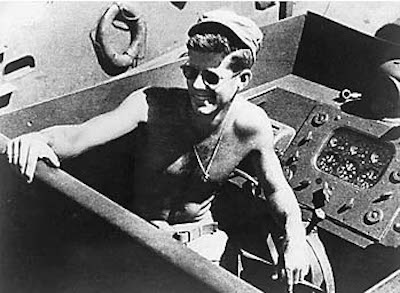Amazing PTs of World War II
Marauders from Melville
by Constance Beck

The following article originally appeared in the Holiday 2002 issue of Newport Life Magazine. It is reprinted here with permission of the publisher and the author.
Despite ever-changing and improving naval technology, America's fascination with PT boats has not diminished over the sixty years since World War II. This interest is likely fueled by their critical and top-secret wartime assignment: to ambush, hunt, and maraud. They landed spies, ferried commands, led beach-head invasions, and laid smoke screens, and as a result were in more frequent contact with the enemy—and at a closer range—than any other surface craft in all of World War II.
More than 60,000 sailors served on PTs, including a future Supreme Court Justice, future senators, congressmen, governors, judges, ambassadors, and even a future United States President, John F. Kennedy. He commanded a PT boat, sunk by the Japanese in the South Pacific. The public's interest in this historic class was piqued again in July 2002 when wreckage found off the coast of the Solomon Islands in the South Pacific was confirmed to be the remnants of JFK's storied PT-109.
PT-109 was one of the 525 MTBs (motor torpedo boats) commissioned by the U.S. Navy in the early stages of World War II. These small, sleek wooden vessels were fast and heavily armed, packing an impressive arsenal of machine guns, torpedoes, smoke generators, depth charges, and hand grenades, as well as a variety of small arms. PT boats were manned with twelve or fourteen men, as naval superstitions dictated the number thirteen unlucky. PT-109, skippered by twenty-six-year-old Lieutenant John F. Kennedy, went down in the early morning of August 2, 1943. Ironically, the vessel, on that fated mission, was carrying thirteen men.
While patrolling the waters for enemy ships that might be running supplies to Japanese troops stationed on the Solomon Islands, PT-109's crew met with disaster. The Amagiri, a Japanese destroyer moving silently and unseen through the impenetrable darkness of a moonless night, rammed the smaller ship, slicing it in two. Two members of the crew of the PT-109 lost their lives, but the remaining ten were led to safety by the leadership of their skipper. The surviving crew swam to the safety of a nearby island, with Kennedy himself pulling along an injured crew member by the strap of his life jacket. The resourceful Kennedy contacted the U.S. Navy by carving a message into a coconut and giving it to a native he encountered. They were rescued within the week.
A National Geographic expedition, led by deep-sea explorer Dr. Robert Ballard, began its search for PT-109 in May of 2002. Ballard, perhaps best known for his 1985 discovery of the Titanic, wasted no time in his thorough examination of the Blackett Strait, where the ship was reported to have gone under, and quickly discovered what appeared to be the wreckage of Kennedy's 109. Within two short months, his findings were analyzed and validated by U.S. Naval experts.
At the request of the families of sailors who lost their lives in that incident, PT-109 will remain undisturbed in its final resting place.
Constance Beck was a resident of Newport and a regular contributing writer to Newport Life magazine. At the time she wrote this article, she was studying to pursue a career in media and journalism. As of 2019 she resides in Laguna Niguel, California.
See a real PT!
Battleship Cove, a historic naval ship collection in Fall River, Massachusetts, allows visitors a rare glimpse into the past. There, visitors can see two of the eleven remaining authentic mosquito boats of World War II, the seventy-eight-foot Higgins PT-796 and the eighty-foot Elco PT-617. Other memorabilia and artifacts from the forty-five PT squadrons are on board the battleship USS Massachusetts.

Related links:
See also Knights of the Sea by Frank Pritchard.
For a more detailed account of John F. Kennedy's military record, including his training at the Motor Torpedo Boat Squadron Training Center in Melville, Rhode Island, and the sinking of PT-109, visit the Naval History and Heritage Command website.